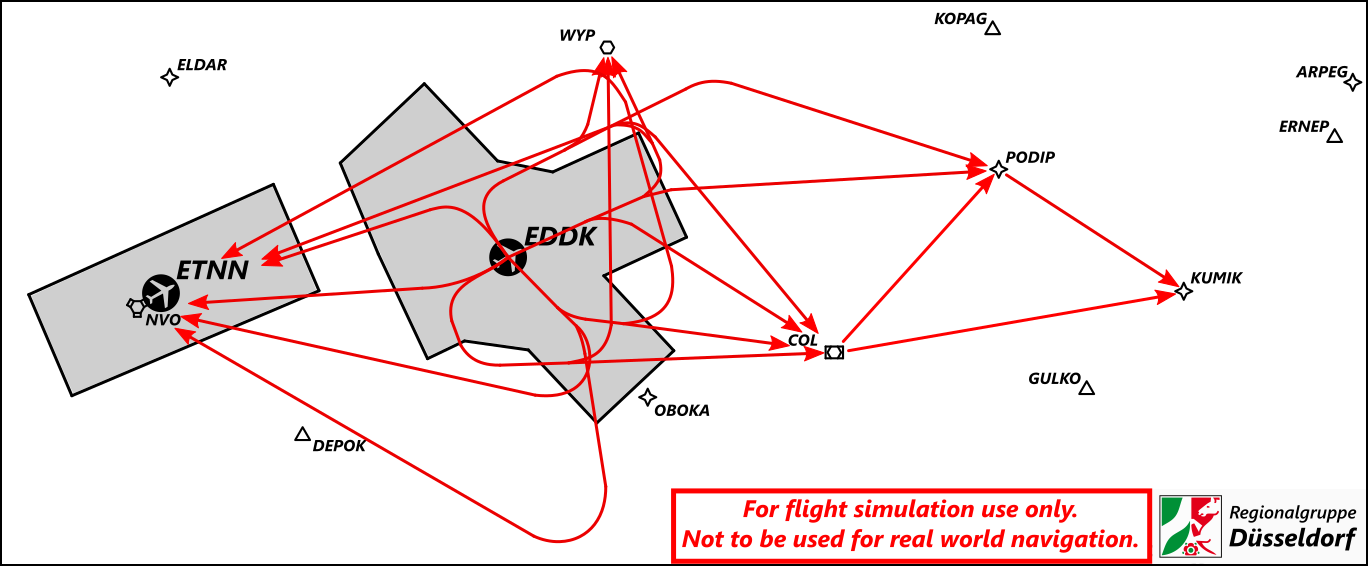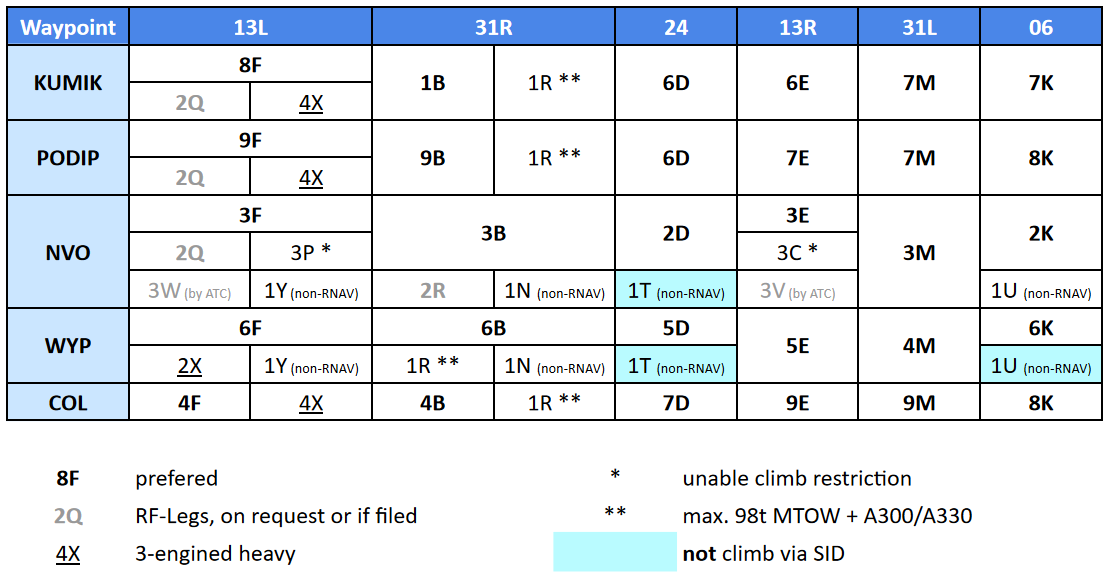EDDK - Delivery
VFR traffic, in contrast to real procedures, does not have to request startup at Delivery, but can report ready for taxi directly to the ground control.
Startup: When startup clearance cannot be given immediately or the pilot is not ready for startup within the next 5 minutes during high traffic situations, the pilot needs to stay on Delivery frequency until he receives startup clearance. If an expected startup time (TSAT) exists, the pilot should be informed about it. This procedure might be necessary during events with a lot of outbound traffic.
Capacity: Due to a limited capacity for outbound traffic on ground, there should not be more than 12 active startup clearances at the same time (including SUG, PBG, TXG).
Euroscope: Delivery shall ensure that the initial climb is set and the correct SID is coded into the flightplan (very important for Center!). When issuing startup the corresponding ground state "SUG" (Startup Given) and the clearance received flag need to be set.
Departure Routes
The standard intrument departure procedures from Cologne-Bonn lead to the waypoints NVO, WYP, COL, PODIP and KUMIK. The initial climb for all departures is 5000 ft MSL. All SIDs except three non-RNAV departures have speed or altitude restrictions, the phrase "climb via SID" need to be used.
 Departure Routes out of Cologne-Bonn
Departure Routes out of Cologne-Bonn
General Restrictions:
- The standard departure routes via COL are only used for local training flights or for flights to Frankfurt/Main EDDF.
Runway 06, 24 and 31L:
- Designators K (RWY 06), D (RWY 24) and M (RWY 31L) are the available RNAV departures.
Runway 13L:
- Designator F is prefered for all RNAV departures.
- Designator Q requires RNAV and RF-Legs capability and should be used only if filed by the pilot or on request.
- Designator X is only used for 3-engines heavies (e.g. MD11).
- NVO#P is used for departures unable to comply with the climb restriction on the F or Q SID.
- NVO#W by ATC only and requires prior coordination with Radar as the SID will cross the inbound stream. It is only used, if certain glider-areas are active (which are not simulated on VATSIM). Appropriate flights must be announced to the approach controller by the tower before take-off.
Runway 13R:
- Designator E is prefered for all RNAV departures.
- NVO#C is used for departures unable to comply with the climb restriction on the E SID.
- NVO#V by ATC only and requires prior coordination with Radar as the SID will cross the inbound stream. It is only used, if certain glider-areas are active (which are not simulated on VATSIM). Appropriate flights must be announced to the approach controller by the tower before take-off.
Runway 31R:
- Designator B is prefered for RNAV departures above 98t MTOW (e.g. B757).
- Designator R is used for all RNAV capable outbounds with MTOW below 98t as well as for A300 and A330.
- NVO#R requires RNAV and RF-Legs capability and should be used only if filed by the pilot or on request.
RWY13R / RWY31L departures can be assigned on a daily basis to small general aviation aircraft, as well as aircraft up to the category of A320/B738 if required. After coordination with Tower, RWY 13R can be used for all light and medium aircraft during high traffic situations.
With westerly winds, outbounds should be asked if they prefere runway 24 (when active) or runway 13L/31R for departure.
Quicksheet - Standard Instrument Departures
Vectored Departures
If pilots are unable to fly a standard instrument departure (even an older version of the current SID) a vectored departure can be coordinated between Delivery and Arrival.
Primary runway heading and an initial climb of 4000ft should be used. Other coordinations are always possible. At Euroscope the SID with RVxxxxx should be selected (xxxxx = first waypoint).
Datalink Clearance (PDC/DCL)
At Cologne-Bonn Airport we offer Datalink Clearance to the pilots throughout the Hoppie System and the Topsky Plugin. The airport code EDDK should be used (already preselected).
An example of the DCL message the pilot will receive can be seen below. Due to plugin limitations, the current default setting is "startup approved"; the Startup option in the DCL window shall be set to "No" for every DCL as pilots need to request startup separately on frequency.
Other DCL messages can be enabled within the Topsky CPDLC settings file manually.
CLD 1051 240418 EDDK PDC 012 EWG6TG CLRD TO LEPA OFF 13L VIA KUMIK2Q SQUAWK 1000 ADT MDI NEXT FREQ 121.855 ATIS R REPORT READY ON 121.855
vSID Rules
The following alias commands (.command<space><enter>) can be used to toogle vSID rules.
| Alias |
vSID Command |
Description |
| .high | .vsid rule eddk high | all L/M outbounds will get runway 13R/31L for departure. |

